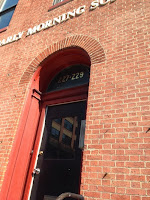 |
| Ghost Ad, 227-229 Holliday St (CharmCityHistory.com) |
 |
| Early Morning Software, Current Occupant (Oct 2013) |
A business by the name of Early Morning Software Incorporated currently occupies the building at this address having signage above the door. In comparison to the Peale Museum adjacent to the south, the building's brick facade seems to have been less maintained and one would be inclined to guess it to have been built earlier, but this is likely not the case.
After some investigative work and with the help of Sanborn insurance maps, we can determine that as of 1902, this building consisted of two separate smaller buildings having the address of 227 and 229 Holliday Street. The second floor of the more northern section, 229 Holliday, was occupied by a "machine shop." From the same map, it sat adjacent to a building that once occupied the north lot from 1847 to 1908, a bell foundry and brass works that was (according to Baltimore Sun classified ads) originally known as Clampitt & Regester, and finally J. Regester's Sons Co. (it is from this location that the original Baltimore City Hall bell was fabricated).
 |
| William T. Harris' Gasoline-Powered Motor Vehicle 1893 (Courtesy: U.S. Patent Office) |
 |
| 2nd Floor Machine Shop at 227 Holliday St (1902 Sanborn Insur. Map) |
Most notably, according to The Antique Automobile, Vol. 33, in 1892, "a man" came into Mr. Hollingsworth's machine shop at this Holliday Street location wanting a steam-propelled passenger wagon for a sight-seeing bus for the World's Fair, but was instead persuaded to change to gasoline power and designed the car. With high certainty the man, referenced in the above book, was a certain William T. Harris who is credited by Encyclopaedia Britannicaas being one of the earliest builders of a gasoline car. In fact, one the earliest patent filings (No. 495733) for a vehicle motor (possibly THE earliest gasoline powered) is that of William T. Harris of Baltimore, MD, likely as a result of Hollingsworth's idea that day. By 1896, William Hollingsworth invented and patented a "Mechanism for Drying Varnished Paper," in 1909, a "Ticket Vending Machine" and in 1926, a "Bronzing Machine," all in addition to the routine manufacturing of positive pressure blowers and combustion engines.
 |
| The Wm. Hollingsworth Building, Circa 1900 (Courtesy: MD Historical Society) |
 |
| "Hollingsworth Bldg." (1914 Sanborn Insur. Map) |
By 1932, his business at this location had grown to the point of being incorporated as the William Hollingsworth Machine Company, but its founder unfortunately died in 1941 without history crediting him with the notoriety of being the brains behind one of the earliest pioneers in modern automobile history. Getting back to our original hint to this part of Baltimore's past, the Hollingsworth ghost ad is at least 70 years old.
(References Courtesy of: Baltimore Sun Newspapers, The Antique Automobile, Vol. 33, Encyclopaedia Britannica, American Machinist Journal)
What a fascinating post. I remember this building well. The last owner of the Hollingsworth Machine Company was my grandfather, Gilbert H. Alford. He was a lifelong Quaker, graduate of Friends School and member of Stony Run Friends Meeting. As a child I remember visiting him in at the machine shop in the late 1960s. I believe that he dissolved the business and sold the building in the early 1970s. My parents still have a wooden Quaker meeting bench that for many years sat in the building's corridor.
ReplyDelete